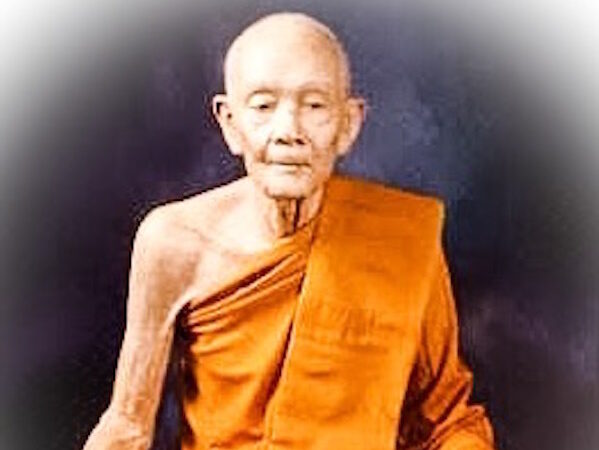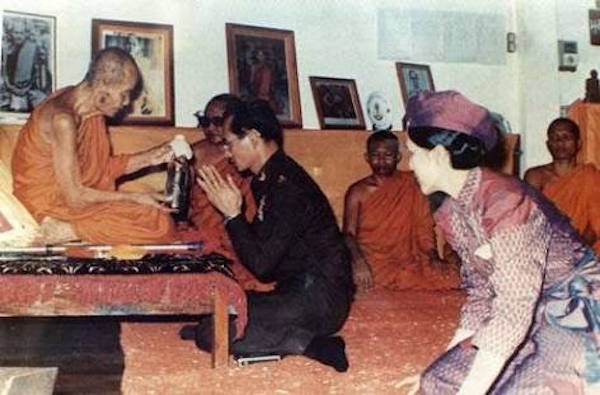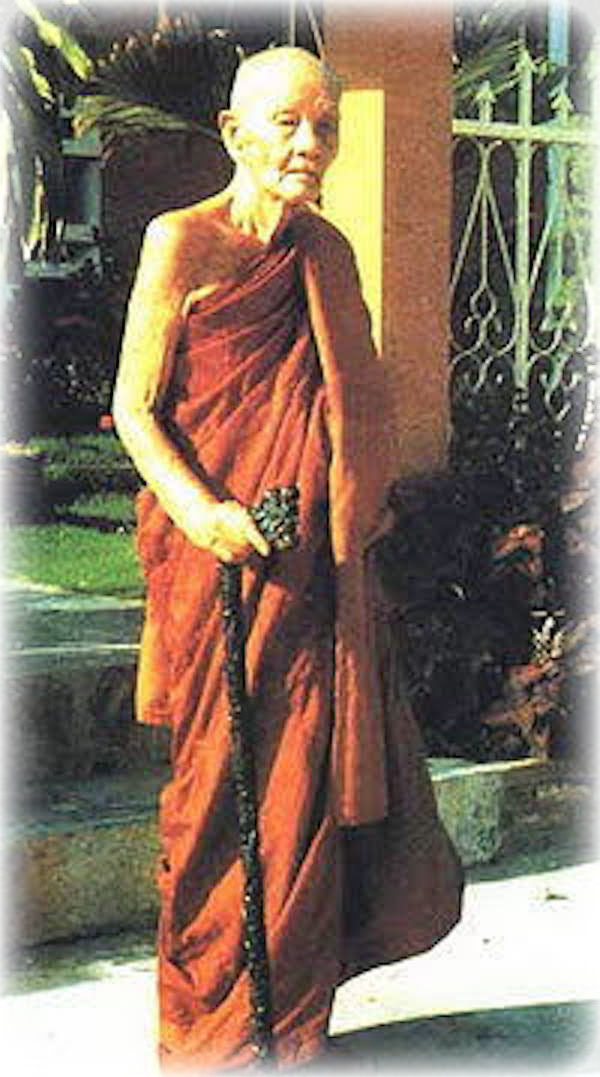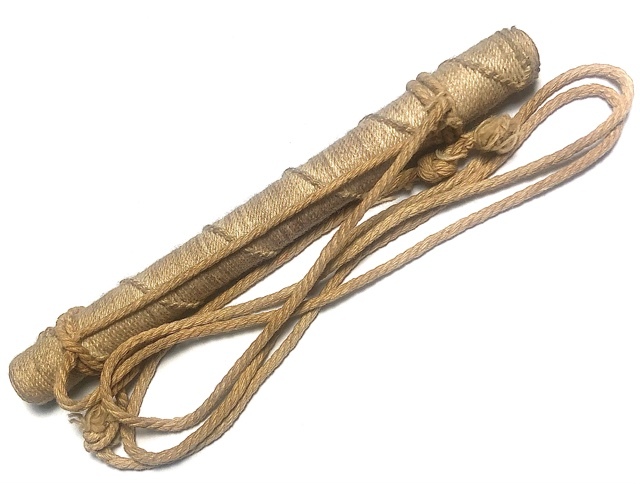
Luang Phu Doon Adtulo, of Wat Buraparam, was a nationally famous and respected Buddhist Monk, and spiritual figure of great renown, was born in the small village of Ban Prasat, which is located in Tambon Chaniang, Surin Province. His birth occurred on the 4th of October in the year 2431 BE, specifically in the second Waning Quartal of the 11th Lunar Month. This places his birth in the autumn season, a time often associated with reflection and change. Luang Phu Doon was the second of four children, making him the middle child in his family. Interestingly, he was the only one among his siblings to reach a ripe old age. While his other siblings unfortunately passed away before reaching the age of 70, Luang Phu Doon lived a long and fulfilling life, reaching the impressive age of 96 years.
Luang Phu Doon, born as the second child in a family of four, had a unique journey towards monkhood. In his early adult years, he pursued a career in the theatre, but his heart was always drawn to the teachings of Buddhism. He frequently visited temples to learn the Dhamma and practice, a testament to his deep-seated interest in the spiritual path. Despite his passion, his parents, relying on him as the main source of income and concerned about the family’s welfare, consistently refused his requests to ordain. They stipulated that if he were to ordain, he should commit to the monastic life permanently, or at least attain the status of temple Abbot before considering disrobing.
After years of persistent requests, his parents finally relented, and at the age of 22, Luang Phu Doon was ordained in the year 2453 BE at Wat Jumpol Sutawas, Surin. His ordination was a significant event, officiated by Pra Kroo Wimon Silaprodt, who served as his Upachaya ordaining officer. Tan Pra Kroo Beuk took on the role of Pra Gama Wājājārn, the prompter, while Pra Kroo Rit assumed the position of Anusāwanājārn. Upon his ordination, Luang Phu Doon was given the Sangha name ‘Udtalō’, a title that signifies ‘Incomparable to Others’. Thus, he became known as ‘Pra Luang Phu Doon Udtalō Bhikkhu’, marking the beginning of his spiritual journey.
Following his ordination, Luang Phu Doon embarked on a spiritual journey to Wat Kor Ko, a temple located approximately 10 kilometers from his place of ordination. His mission was to learn Kammathana Vipassana practices under the guidance of Luang Por Aek. In the tradition of those times, the disciple was expected to adhere strictly to the teachings of their Kroo Ba Ajarn, or spiritual instructor. Luang Phu Doon, therefore, meticulously followed Luang Por Aek’s instructions, which were unusually simplistic.
The practice involved lighting five candles and chanting a prayer, ‘Khor Anchern Pra Pīti Tang Ha Jong Ma Ha Rao’, which translates to ‘I beseech the 5 Pīti Raptures to come to me’. Luang Por Aeg did not provide any additional methods or techniques to accompany this practice. Despite Luang Phu Doon’s diligent and repeated attempts, he was unable to experience any of the five Pīti raptures, a situation that might have been frustrating but also served as a stepping stone in his spiritual journey.
Luang Phu Doon was a devoted meditator who spent countless hours in the practice of Dhyana, but despite his efforts, he failed to experience the five raptures associated with the five candles. Despite his dedication and repetition, he found the practice to be more symbolic than practical, and he began to lose interest. In addition to his meditation practice, Luang Phu Doon also began to practice fasting, which caused him to become very thin and wizened. However, even this extreme form of self-denial did not seem to bring him any closer to enlightenment.
As the months passed, Luang Phu Doon became increasingly disillusioned with his meditation practice. He had heard stories of other meditators who had experienced profound insights and spiritual breakthroughs, but he had yet to experience anything of the sort. Despite his best efforts, he felt as though he was stuck in a rut, unable to make any progress towards his goal of enlightenment.
Despite his frustration, Luang Phu Doon refused to give up. He continued to practice meditation and fasting, hoping that eventually, he would experience a breakthrough. However, as the days turned into weeks and the weeks turned into months, he began to lose hope. He wondered if he was doing something wrong, or if he was simply not cut out for this type of spiritual practice. Despite his doubts, he continued to push forward, determined to achieve his goal no matter what it took.
After 6 years at Wat Kor Ko, Luang Phu Doon finally let go of any hope of the methods working, and went to study Paryatti Dhamma Theory at Wat Sutat Temple, in Ubon Rachathani, and became the first student from Ubon Rachathani to attain the Batchelor of Arts Degree in Dhamma Theory. Luang Phu Doon studied Pali Sanskrit Grammar, and became able to Translate Tripitaka Suttas from Pali to Thai.
Due to the fact that Wat Sutat was a Dhammayut Nikaya lineage temple, and Luang Phu Doon was a Maha Nikayta lineage monk, Luang Phu saw fit to ask to change lineages to become a Dhammayut Nikaya. And so in the year 2461 BE, he changed lineages, and remained at Wat Sutat.
Luang Phu Doon Practices Tudong with Ajarn Mun Puritadto
It was hereafter at Wat Sutat, that the Great Arahant Luang Phu Mun Puritadto came to visit, and Luang Phu Doon was able to listen to this great Attained Master Monk teach Dhamma. After one single Dhamma talk, Luang Phu Doon became so fervently faithful of the methods of Luang Phu Mun, that he beseeched his Metta to allow him to follow and practice with Ajarn Mun. Luang Phu Doon then went on Tudong Forest Wandering with the great Ajarn Mun Puritadto, and remained practicing the Vipassanā Kammathāna methods as taught by the Great Master and Guru of the Thai Forest tradition Tudong Sangha lineage, Pra Ajarn Luang Phu Mun Puritadto.
After some years, the Bishops of Nakorn Rachasima asked Luang Phu Doon to return to Surin, to preside over the restoration of the temple of Wat Buraparam in Surin. Luang Phu then had to cease his Tudong Practice with Luang Phu Mun, and dedicated the rest of his life to diligently improving and administering the temple of Wat Buraparam.
It was then during his Years of Post Tudong mastery, where Luang Phu Doon began to release amulets to his Devotees, using the powers and Wicha he had developed in the forest throughout the many years he spent practicing under the great Master of all Forest tradition Sangha Monks, Luang Phu Mun Puritadto. Luang Phu Doon began to officially release amulets somewhere around the year 2470 BE onwards.
Luang Phu Doon is considered one of the Great Arya Sangha Ascended Masters and is a highly revered monk for Thai Buddhist Folk, wand even revered by many members of the Royal Family of Thailand. Luang Phu Doon Passed Away at Wat Buraparam, on the 18th of December 2522 BE and was visited by many of the high members of the Royal Family, who travelled to Wat Buraparam to pay respects and to perform the Funeral Cremation Pyre lighting ceremony for Luang Phu Doon.
The amulets of Luang Phu Doon are all highly Sacred and Revered objects for Thai Buddhist People, and are extremely rare to find. Luang Phu Doon amulets are all highly esteemed classics and are members of the Pra Niyom Category, valid for entry in competitions of National Status.
Luang Phu Doon is famous for his Dhamma Parable teaching;
“จิตที่ส่งออกนอก เป็นสมุทัย ผลอันเกิดจากจิตที่ส่งออกนอก เป็นทุกข์ จิตเห็นจิตอย่างแจ่มแจ้ง เป็นมรรค ผลอันเกิดจากจิตเห็นจิต เป็นนิโรธ”
“The Mind which looks Outwards, is Samutaya (cause of suffering and dissatisfaction), the Fruits of a Mind which looks Outwards, is Dhukkha (Suffering and Dissatisfaction), a Mind which sees the Mind Clearly, is Magga (the Path to the End of Suffering and Dissatisfaction), and the Fruit which is born of a Mind which can See the Mind, is Nirodha (Cessation of Suffering and Dissatisfaction)”.


